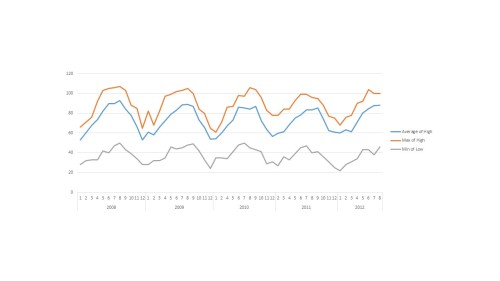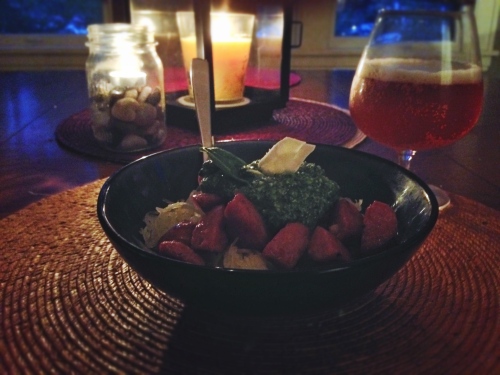Have you ever wondered why white wines and red wines seem to have completely different aromatic descriptions? White wines are all about citrus and tropical fruits and maybe hints of butter and vanilla and red wines focus on red and black fruits with maybe earthy things like leather, tobacco, oak, and just straight up meat. But what do they have in common? I mean, regardless of whether it’s a red grape or a white grape, it’s still a grape, right?
If you rely on the aroma descriptors that you get from the back of the bottle, or a “wine expert” (like me!), or even the winemaker themselves, you will rarely find any that overlap in the Venn-Diagram-Of-Red-And-White-Wine-Aroma-Descriptors…pretty sure that’s a thing…it’s not a thing on the internet, so let’s make it:

…so no overlapping there…NOT. A. SIN. GLE. ONE.
(all of these flavor descriptors were taken from Wine Enthusiast articles and a little Editor’s note here, I took out “Watermelon” as a descriptor for Merlot because only WE lists watermelon as a descriptor for Merlot).
Why is this? Why do we not describe red wines and white wines as having any overlapping characteristics?…I’ll hold you in suspense a little longer. Perhaps a more peculiar case first:

What inspired this investigation was drinking the Blanc de Cabernet Franc from Leah Jorgensen Cellars. This is a white wine made from the Cabernet Franc grape which is usually made into a red wine. She also makes the red version and yes, they are both fantastic. But what piqued my curiosity was how each wine was being marketed. This is the same grape, from approximately the same location (She buys her grapes from a few different vineyards it looks like, so it’s tough to say the exact grapes used for the red version came from the same place that the white version grapes came from), made by the same winemaker; the only apparent difference is that in one version, the skins of the grapes were left on, and the other, they were left off*. Yet, here are how the two wines are described:
White – The world’s original white Cabernet Franc – this medium-bodied wine typically has delicate nuances of “early blush” apricot, golden raspberries, Meyer lemon, blood orange, white tea leaf, tarragon, and hazelnut – making up a pretty, complex white wine from red grapes. This vintage, the wine also offers subtle botanical notes of elderflower, jasmine, lime blossom, sweet pea shoot, even a hint of ground cinnamon, with flavors of clementine, lemon meringue, light honey leading into a creamy and nutty mid-palate that finishes with refreshing salinity. Drink now for freshness, but this wine will age in the bottle for a minimum of five years, due to the phenolic content from the red skins. Pair with white fish or shellfish, especially oysters and scallops; pasta with simple cream sauce; pork chops with apple compote; roasted chicken; crab stuffed poblano peppers with cream sauce; polenta and beans; a young, creamy, nutty Gruyère.
Red – This wine expresses fresh, bright, vibrant aromatics lifting and floating above the glass, brimming with intense floral notes, perfume, and sweet fruit. This wine was like a bouquet of flowers saved from a precious occasion, hung carefully upside to dry and preserve the natural oils – rose petals, hibiscus, violets, carnations. It reminded me of a delicate floral fragrance I wore when I was a young woman – “Petite Cherie” by Annick Goutal – not for the individual scents of pear, peach, musky rose, freshly cut grass, and vanilla (those descriptors really sound more like a portrait of white wine, anyway), but, for the sum of its parts, the alchemy of these scents that, when coalesced, create something that smells nothing like the individual oils, but, something of a magical emanation created by some ethereal woodland fairy queen. Then, another swirl of the glass sparked cinnamon bark, cigar, sweet birch bark, the distinctive spicy-citrus aroma of black walnut leaves, brambles, and ripe cherries.
Notice in the description of the red wine it’s even mentioned that some characteristics seem like they should be describing a white wine…just not the white wine made from the same grapes by the same wine maker. Since a good portion of wine aromatics are determined by the grapes themselves, it would stand to reason that these two wines should at least have something in common aromatically speaking, shouldn’t they?
Now let’s look at the reasons as to why there appear to be zero similarities between how red and white wines smell and taste. I would contend that most of this disparity is a result of how we interpret the aromas coming out of the wine we are drinking and less to do with actual chemical differences between red and white wines. In the world of research, this very much appears to be a undecided question, but here is my reasoning:
- Our sense of smell is influenced by a whole host of things that aren’t just aroma molecules hitting our smell receptors: memory/training, mood, and the remaining 4 senses, with emphasis on sight. When we see a food of a certain color our brains, in an effort to be as efficient as possible put all of the memories of similarly colored foods in the fronts of our minds to compare the current item with. You could call it laziness, but we seem to stop with whatever the brain serves up first instead of consciously digging deeper.
- Aromatic descriptions used in wine, beer, whiskey, tea, coffee, etc. are developed for the primary purpose of comparing and contrasting when having a live discussion. However, we already have categorized a wine into whether it is red, white, or rose before we get to smelling it so if someone goes about comparing and contrasting wines in different color categories, there’s already an assumption that everything will be different. Aromatic descriptions are actually not a great way to categorize wine from a global perspective.
- Aromas, chemically speaking, can either be fairly simple (butter = diacytel) or complex (coriander = pinene, 3,7-dimethylocta-2,6-dienal [citral], linalool, and camphor)…and even with the “simple” aromas, it really is a mix of chemicals that exist, but one just tends to dominate. Then, to make this even more complicated, there is an incredibly wide range as to the potency of these aromatic compounds. Just looking at the variants of methoxy-pyrazines, which are responsible for those vegetal aromas, our noses can detect them at 0.000002 ppm in water or white wines or 0.00001 ppm in red wine. In normal speak, these are tiny, tiny amounts; fractions of a drop. For diacytel, the detection threshold can range from 0.2 ppm in white wines to 2.8 ppm in red wines. This means that you need 100,000+ times the amount of diacytel to be present than a methoxy-pyrazine in order for us to smell it! Not only does these threshold levels vary between white and red wines, but they can also vary between white wines and between red wines. These variations are the best evidence to say that there actually could be distinct and disjointed aromatic differences between white and red wines, BUT (and I like big ‘buts’ (I cannot lie)) the thresholds appear to work on a spectrum, meaning there is bound to be some overlap somewhere. The research on this topic is nowhere near where it needs to be to make any definitive statements.
Therefore, the next time you are sitting around intellectually comparing and contrasting a curated selection of wines (Pretty much a Tuesday, right?), try stretching your mind a little and asking yourself what a white wine and red wine could have in common. For example, take a food like fennel or the spice anise and see which white wines it brings out those attributes in and which red wines it brings out those attributes in. I don’t say this lightly, but you may just blow your own mind.
*Chances are different yeasts were used and some oak in the red, but the wines were most likely fermented in the same tanks, at similar times, with the same bacteria roaming around, by the same hands. Additionally, it looks like the the white wine also underwent a bit of Malolactic Fermentation (which most reds go through), so the differences between how the two wines were made are slight.












![[Insert glass of red wine here to be trendy]](https://aaronberdofewine.files.wordpress.com/2012/12/blueberryplantation.jpg?w=500&h=500)






